While often not as common as yellow and white flower weeds, purple flower weeds can be just as frustrating for commercial landscape experts and residential homeowners. Weeds with purple flowers often start off looking like a nice addition to your landscape but can frequently take over areas from “pretty flower” to a giant mess.
In this article, I will share with you how to identify common purple-flowered weed types and offer some tips on eliminating them.
You may also be interested in identifying yellow flower weeds.
14 Most Common Weeds With Purple Flowers
I’ve listed these weeds in order of the likeliness of the weed appearing in your yard. This will vary depending on your growing region.
#1. Bull Thistle (Cirsium vulgare)

Bull thistle is a recognizable weed with robust individual flowers that sit upon a prickly ball. It is also a common food source for pollinators like bumble bees. Did you know that bull thistle is now common throughout the United States?
Growing up to ten feet tall, this plant loves to spread through disturbed soils but will also make its way into lawns and gardens. The plant’s leaves are lobed, and the plant can have prickly spines.
To remove: Early prevention is key. Using a pre-emergent herbicide in spring months, keeping your lawns mowed helps keep Bull Thistle away. Once established, pull the plant from the ground and dispose of it. You will want to wear gloves to prevent irritation or injury from the prickly spines.
#2. Creeping Thistle (Cirsium arvense)
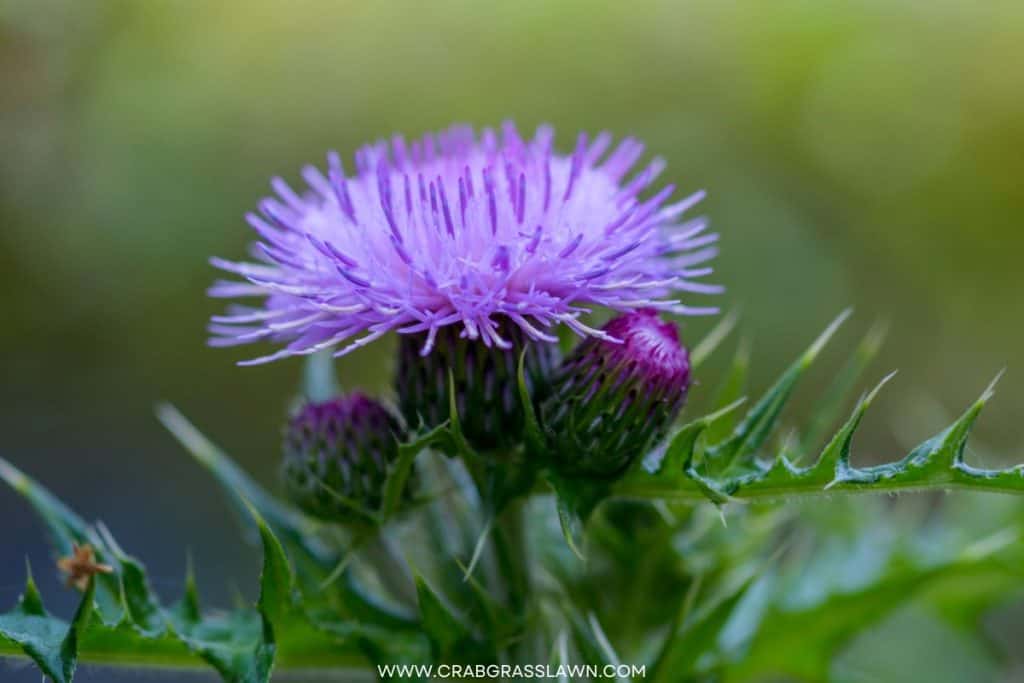
Creeping Thistle weed grows up to five feet in height and features a fuzzy ball-type flower at the end of each stem that blooms in mid-spring to late summer. This plant thrives in disturbed areas and along the side of the road.
To remove: If you have a plant or two growing, you can hand-pull them by the root, but once a number of them are in one place, this can be difficult due to the weed’s extensive weed systems. A healthy garden containing lots of stored nutrients will keep Creeping Thistle from growing and will promote healthy growth for desirable garden plants.
#3. Forget-Me-Nots (Myosotis sylvatica)
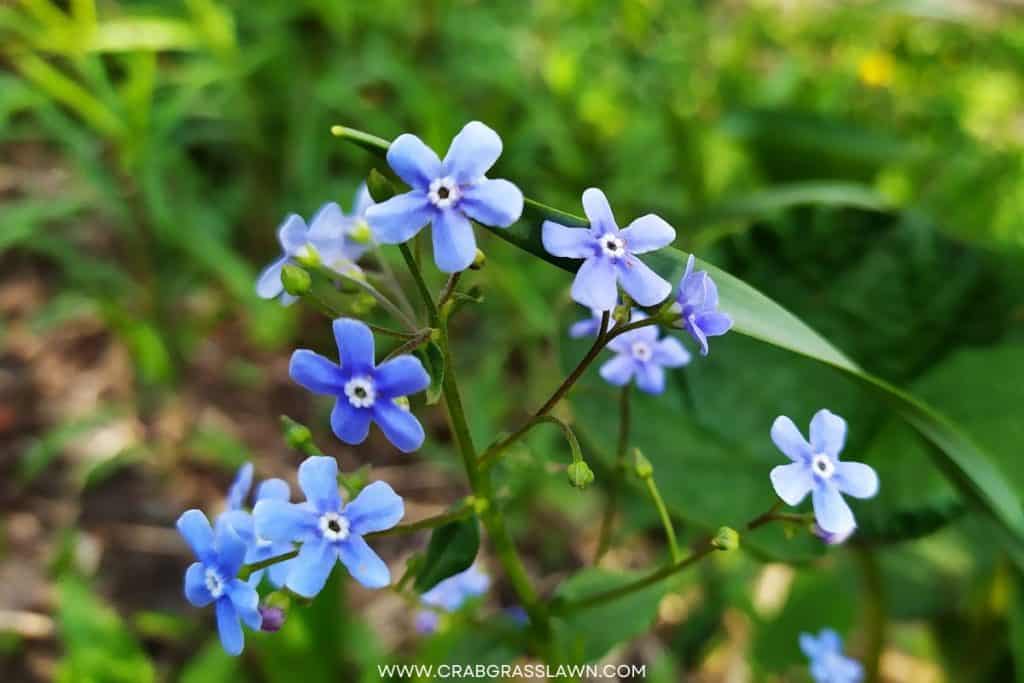
Forget-Me-Nots produce an attractive purple or white flower with a yellow center, with a small black dot. They thrive in moist soil that drains well. While attractive, they can grow very aggressively. You will often see this plant used for border planting, but if not cared for, it can become an invasive weed, creeping into lawns and other garden areas.
To remove: Preventing these weeds from taking root or seeding in areas you don’t want them is the most effective elimination method. They can be hand-pulled from gardens, but once they creep into the grass, it’s nearly impossible to remove them by hand, and you’ll have to use a herbicide application method. A thick, healthy lawn is also a great natural barrier to keep these weeds from spreading into your grass.
#4. Purple Dead Nettle (Lamium purpureum)
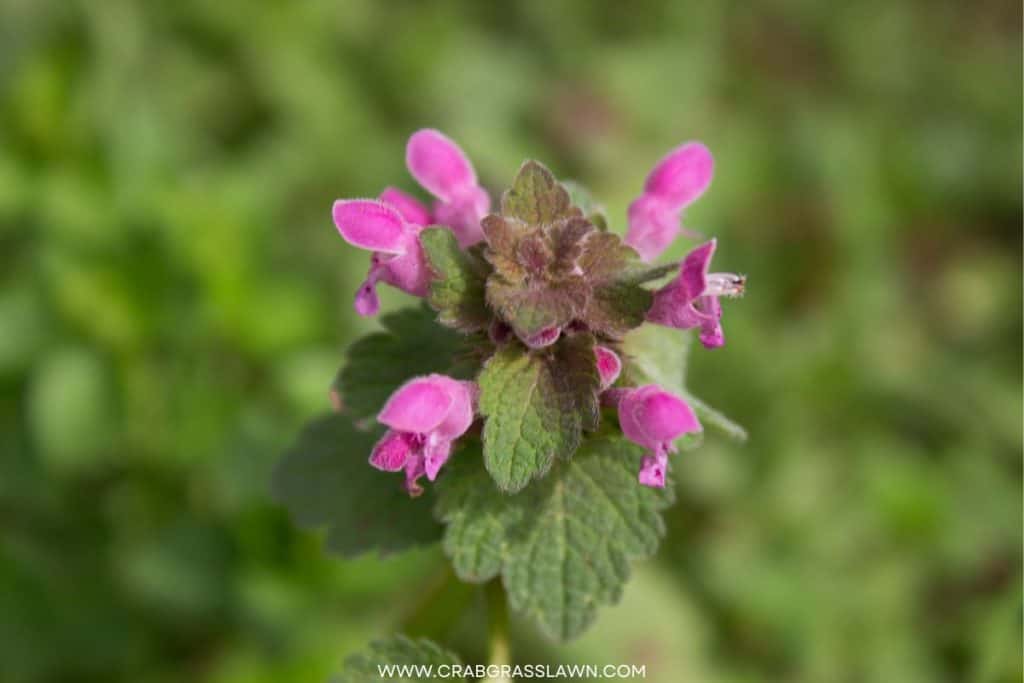
This hardy member of the mint family can survive in pretty tough terrains. It is a favorite among many gardeners because the flowering plant attracts many pollinators. When neglected, it can take over large spaces quickly. The pesky weed has heart-shaped leaves and flowers with a hood on top and two lower petals at the bottom.
To remove: Once established, hand pulling can be difficult due to its extensive root system and ability to mix in with desirable plants and grass. This makes it an ideal candidate for herbicide application removal.
#5. Black Nightshade (Solanum nigrum)

Black Nightshade is a neat plant that can provide relief from ailments like pneumonia, joint pain, and toothaches. Despite its medicinal properties, this annual plant can be problematic because it can spread to unwanted areas quickly.
To remove: You can try digging it out if you don’t have a lot of Black Nightshade growing. Ensure that you dig deep enough to remove the entire plant. If you are growing the plant intentionally, regularly trim it to keep it from turning from a welcome garden guest to an invasive plant.
#6. Creeping Charlie (Glechoma hederacea)
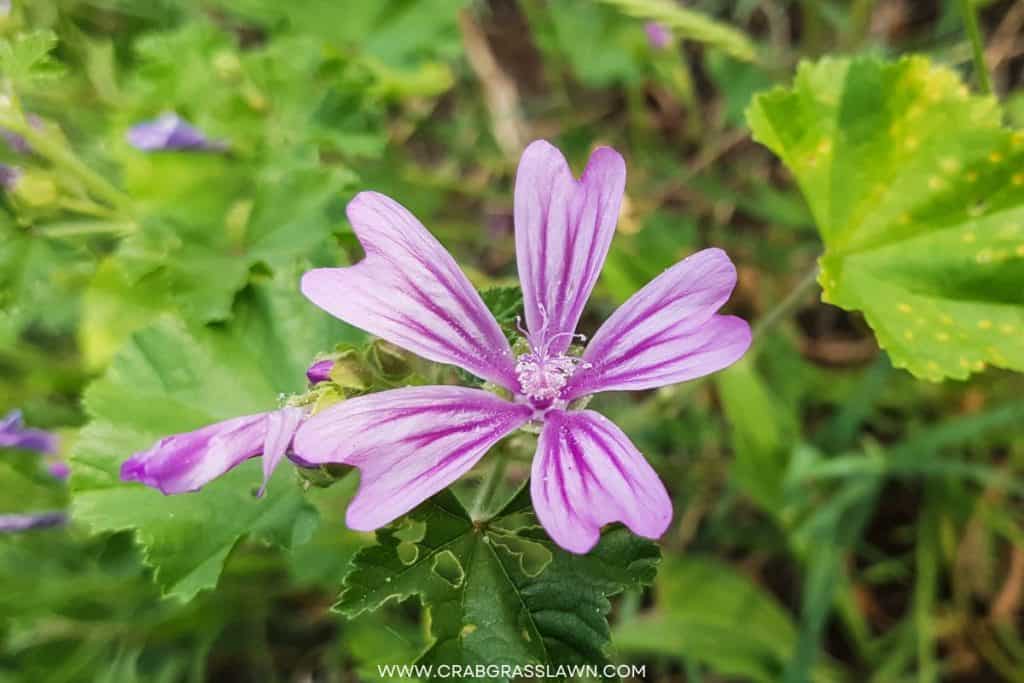
Creeping charlie or Ground Ivy is a broadleaf weed member of the mint family. Not only does it use its creeping stems to spread, but it will also spread by seed and rhizomes.
To remove: Good luck trying to pull these weeds. Their extensive root systems make this plan nearly impossible to pull the entire plant completely. In most cases, a broadleaf herbicide is the best remedy for overgrowing Creeping Charlie.
#7. Henbit (Lamium amplexicaule)
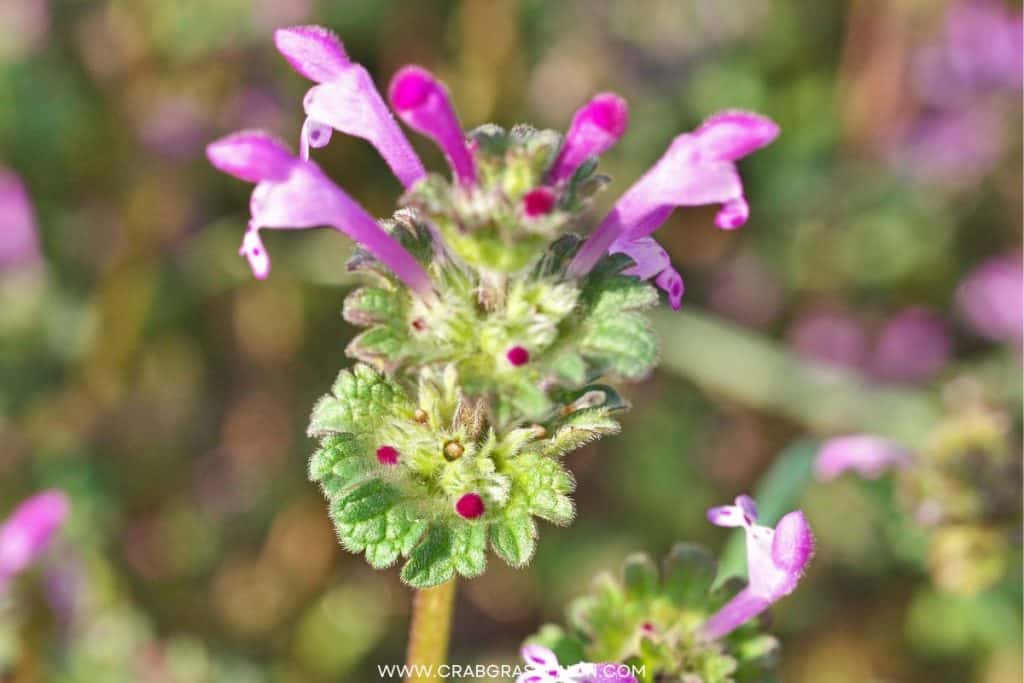
Henbit grows over a foot tall and produces heart-shaped leaves and small, skinny purple flowers that bloom in the early spring to fall. Its seeds can remain viable for close to 5 years. Read more about henbit weed.
To remove: Removing this invasive species from lawns and flower beds before it seeds is critical for its control. A pre-emergent herbicide will go a long way in keeping this purple weed out of your lawn.
Once established, its prolific seed production can be a real problem. Using a broadleaf herbicide and applying it as needed after the first application will help keep your yard free of Henbit.
#8. Musk Thistle (Carduus nutans)
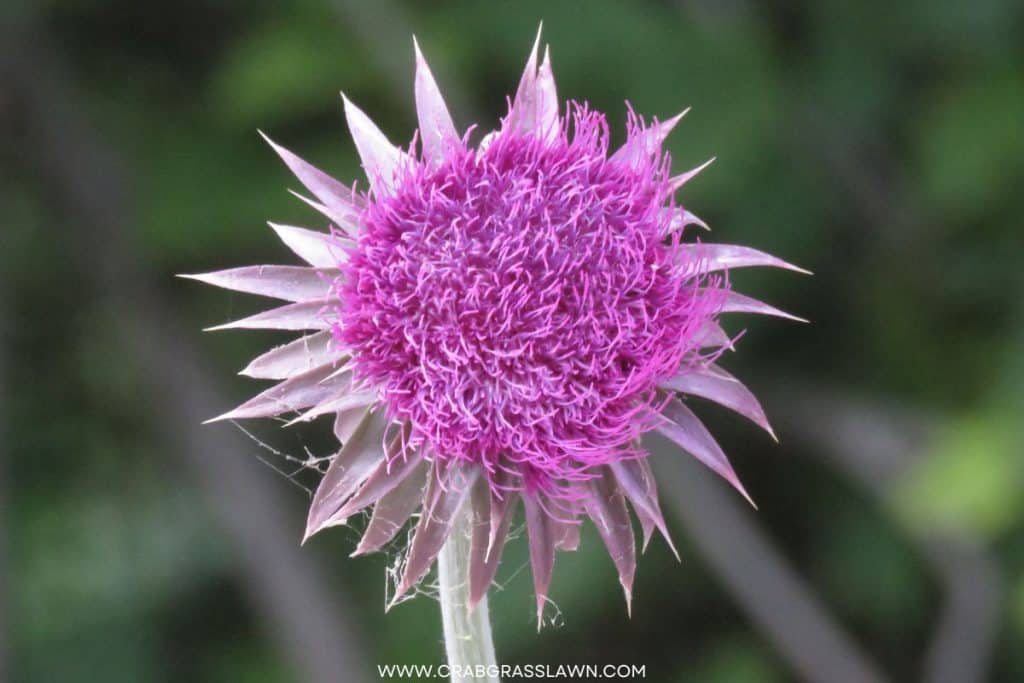
Musk Thistle can grow up to six feet tall and produce well over 100,000 seeds in its lifetime, these noxious weeds can provide a lot of challenges. Native to Europe and Asia, it can now be found in many parts of North America.
The hardy plant blooms from late spring to early fall. The globose heads stand above a body that includes sharp leaves.
To remove: Prevention of Musk Thistle is key. Well-establish perennial grass will help Musk from growing. Once it has become established, hand-pulling by the root is the best removal method.
#9. Dove’s-foot Crane’s-Bill (Geranium molle)

The Dove’s-foot Crane’s-bill has purple flowers that often have a pinkish tip that blook from spring into the early days of fall. It prefers dry areas and grows well with grasses.
To remove: Early control is the best way to keep these weeds. Apply a pre-emergent herbicide, and keep your grass mowed. If you have cut the Dove ‘s-foot Crane ‘s-bill, clean up the debris so seeds do not spread. You may need to use herbicide in lawns that have become infested with Dove’s-foot Crane’s-bill.
#10. Selfheal (Prunella vulgaris)
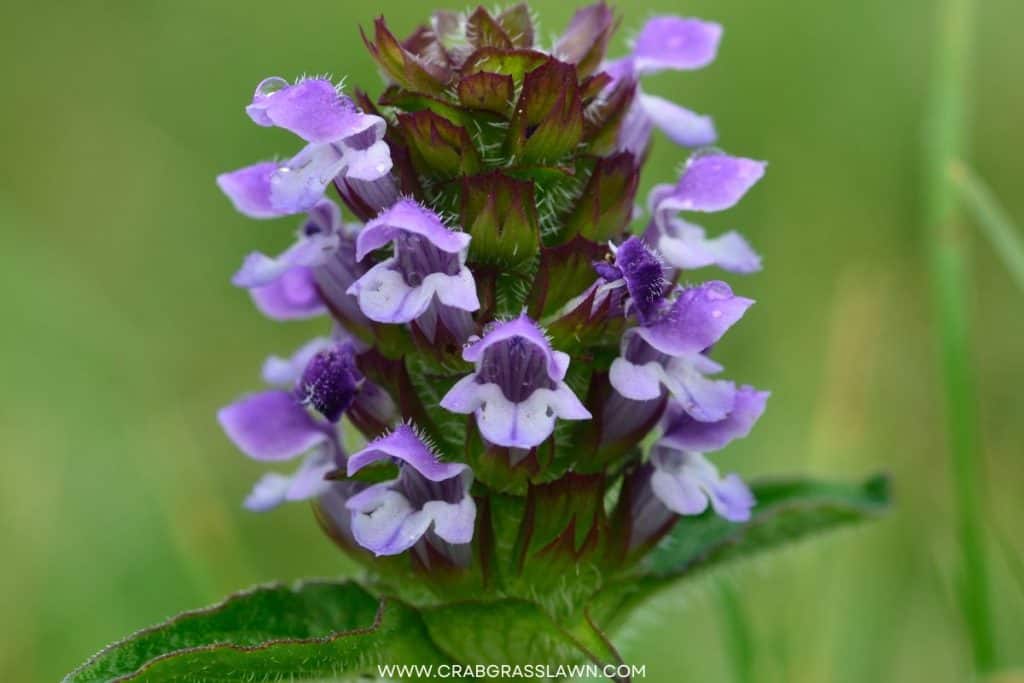
Selheal has been used by many cultures medicinally for a long time. All plant material is edible. It blooms from June to August and has purple or white flowers. It has oblong green leaves, and while it has many great health benefits, it can overtake sunny landscapes quickly.
To remove: If you are trying to grow this weed, but want to contain its growth, cut the plant back after it has stopped blooming. If it’s invaded your entire landscape area, use a herbicide to remove it.
#11. Wild Violets (Viola Odarata)

Wild violets have large pointed leaves and small flowers. They spread wildly through an extensive root system. While they prefer moist soil, they will do well in dry areas once they mature. Did you know wild violets spread via underground stems called rhizomes?
To remove: If you catch them early, hand-pull them, making sure you pull the underground rhizomes will them, or they will regrow. If you have an infestation, especially on your lawn, you may need to use a chemical herbicide application.
#12. Heal-all (Prunella vulgaris)
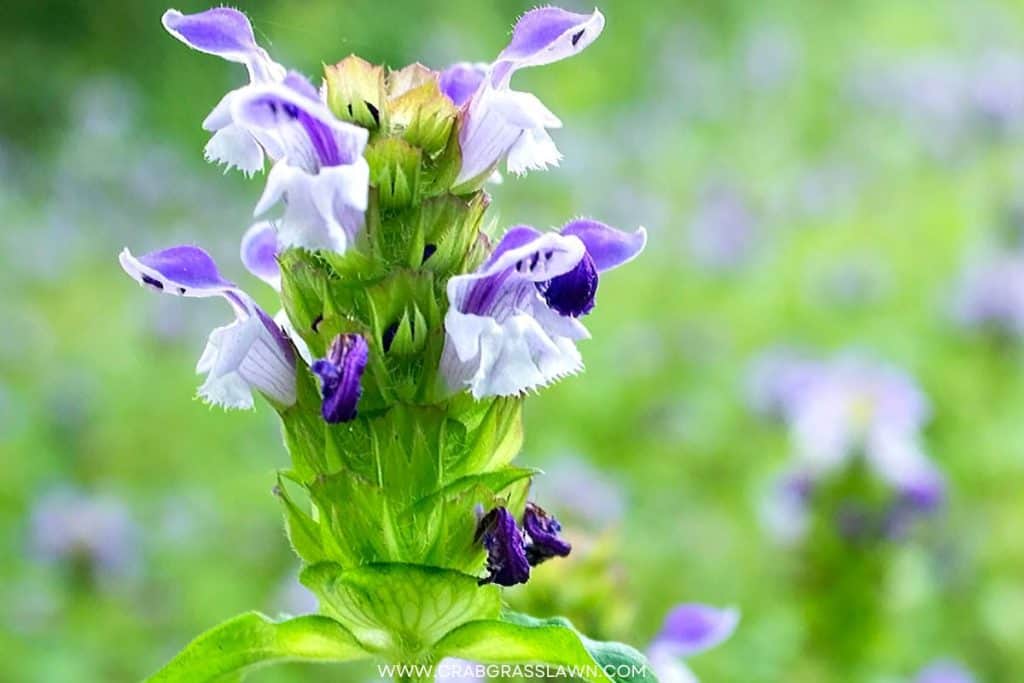
This perennial member of the mint family can grow up to two feet tall, has serrated leaves, and its flower looks like a club. It gets its name from its natural properties that can be used to treat multiple internal and external ailments.
To remove: Commonly found in woodlands, waste areas, and woodlands, the Heal-all can take over areas quickly and become a noxious weed. The best way to remove Hal-all is to remove it by hand and dispose of the plant, root, and all.
#13. Bittersweet Nightshade (Solanum dulcamara)
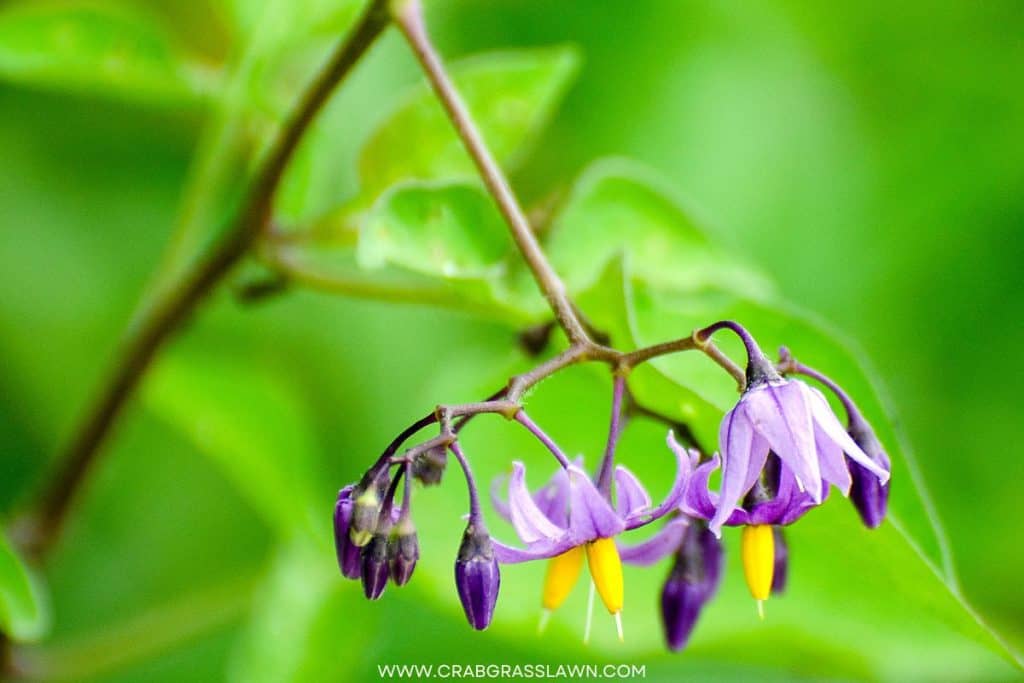
Unlike other nightshade plants, this plant is toxic to humans. It has purple, star-shaped flowers and a yellow cone.
To remove: Small patches of this plant can be removed by digging out the roots and disposing of them. Larger patches will require an herbicide application.
#14. Lavender (Lavandula)
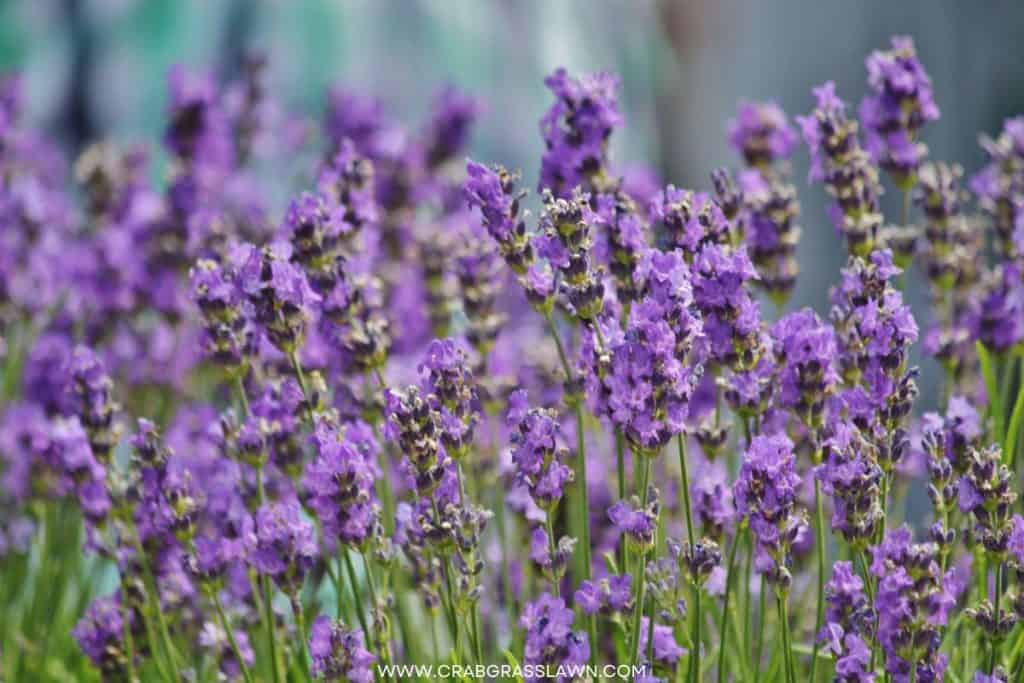
Lavender? A weed? I’ve included it in this list because lavender can become a problem in fields and pastures where it just isn’t wanted. Known for its sweet smell, this edible weed can grow quickly in favorable conditions.
To remove: Lavender is pretty easily removed by digging it up, especially in the spring and early summer. Before tossing it, see if someone you know wants it. You’ll likely be able to find someone to take it off your hands.
FAQs about Purple Flower Weeds
Q: Purple Flower Weeds: Pros and Cons
Pros – The benefits of weeds with purple flowers are numerous. Many are edible ground cover plants, while others provide a great food source for pollinators.
Often, these flowers will grow in shady landscape areas where other plants will not grow or provide beautiful flowers in summer months that don’t require much maintenance.
Cons – Purple flower plants often spread quickly, are difficult to remove, or can choke out desirable garden plants
Q: What are the tall weeds with purple flowers called?
A: Purple flowered weeds can grow many feet in height, many feet in diameter, and many feet deep, and can be tough to remove. Use the table to help identify which purple is growing in your space.
Q: How Do I Identify Weeds With Purple Flowers?
A: Purple-flowered weeds can grow in sunny landscapes or shady landscape spaces. Fortunately, they are usually pretty easy to identify. Use the table provided to help you learn a little about what you are growing and how to remove it.
Q: What is this purple flower with a very strong unpleasant scent?
A: This is likely a nightshade family member and most likely a Bittersweet Nightshade plant. These plants toxic plants have a very unpleasant odor.
Q: What is this purple flower with a very pleasant scent?
A: Many flowers produce purple flowers that smell wonderful. These include lilacs, lavender, violets, and many more.
Hi, Alex Kuritz here. Growing up I remember that my family had one of the best lawns in the neighborhood. Richly green and lush. I did a lot as I grew up in terms of caring and tending for not only my family’s lawn but also my neighbors. I can say I have years of experience, and I am here to share it with you.


